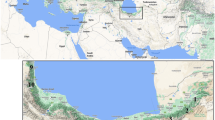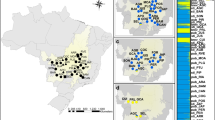Abstract
Curcuma zedoaria (Christm.) Roscoe, a member of the family Zingiberaceae, is one of the most widely distributed Curcuma species in Bangladesh. It is a well-known and important species because of its medicinal and horticultural values. However, some plant populations are predicted to be depleted due to habitat destruction and due to extensive collection by local inhabitants. In order to estimate the level of genetic diversity within and between natural populations, RAPD analyses were performed using individual plants from different populations. We used Shannon’s index to partition genetic diversity which clearly demonstrated that hilly populations of Srimangal, Chittagong and Sitakundu maintain rather higher genetic diversity than that of plain land and plateau land populations of Savar and Birganj, respectively. We found a high intrapopulational (H′pop/H′sp) genetic diversity of 0.717 that was higher than the interpopulation diversity G ST[(H′sp−H′pop)/H′sp] value of 0.283. Principal Coordinates Analysis (PCoA) showed that individuals of the hilly populations were combined in one group, separated from the plain land and plateau land populations. From a conservation point of view, our results suggest that special attention should be kept on the small populations of plain and plateau lands that are critically threatened due to high anthropogenic activities.
Similar content being viewed by others
References
Apavatjrut P, Anuntalabhochai S, Sirirugsa P, Alisi C (1999) Molecular Markers in the identification of some early flowering Curcuma L. (Zingiberaceae) species. Ann. Bot. 84: 529–534
Bussell JD (1999) The distribution of random amplified polymorphic DNA (RAPD) diversity amongst populations of Isotoma petraea (Lobeliaceae). Mol. Ecol. 8: 775–789
Chalmers KJ, Waugh R, Sprent JI, Simons AJ, Powell W (1992) Detection of genetic variation between and within populations of Gliricidia sepiun and G. maculata using RAPD markers. Heredity 69: 465–472
Dice LR (1945) Measures of the amount of ecological association between species. Ecology 26: 297–302
Doyle JJ, Doyle JL (1990) Isolation of plant DNA from fresh tissue. Focus 12: 13–15
Hamrick JL, Loveless MD (1989) The genetic structure of tropical tree populations, association with reproductive biology. In: Bock JH, Linhart Y (eds) The Evolutionary Ecology of Plants. Westview Press, Boulder, pp. 129–146
Holsinger KE, Gottlieb LD (1991) Conservation of rare and endangered plants, principles and prospects. In: Falk DA, Holsinger KE (eds). Genetics and Conservation of Rare Plants. Oxford University Press, New York, pp. 194–208
Lacerda DR, Acedo MDP, Lemos JPF, Lovato MB (2001). Genetic diversity and structure of natural populations of Plathymenia reticulata (Mimosoideae) a tropical tree from the Brazilian Cerrado. Mol. Ecol. 10: 1143–1152
Lewontin RC (1972). The apportionment of human diversity. In: Dobzhansky T, Hecht MK, Steere WC (eds), Evolutionary Biology, vol. 6. Appleton-Century-Crofts, New York, pp. 381–398
Maciel N, Criley RA (2003) Morphology Growth and Flowering Behavior of Curcuma zedoaria. Acta Hort. (ISHS) 624: 111–116
Matsuda H, Ninomiya K, Morikawa T, Yoshikawa M (1998) Inhibitory effect and action mechanism of sesquiterpebes fro Zedoaria rhizome on D-galactosamine/ lipopolysaccharide-induced liver injury. Bioorg. Med. Chem. Lett. 8: 339–344
Morden CW, Loeffler W (1999) Fragmentation and genetic differentiation among subpopulations of the endangered Hawaiian mint Haplostachys haplostachya (Lamiaceae). Mol. Ecol. 8: 617–625
Paisooksantivatana Y, Kako S, Seko H (2001) Genetic diversity of Curcuma alismatafolia Gagenp. (Zingiberaceae) in Thailand as revealed by allozyme polymorphism. Genet. Res. Crop Evol. 48: 459–465
Purseglove JW (1974) Tropical Crops Monocotyledons. Longman Group Ltd., London
Purseglove JW, Brown EG, Green CL, Robbins SRJ (1981). Spices. Vol. 2. Chapter 9 Tropical Agriculture Series. Longman, London, New York
Rohlf FJ (2000) NTSYSpc. Numerical Taxonomy and Multivariate Analysis System ver. 2.1. Exeter Software, Setauket, New York
Sasaki Y, Fushimi H, Cao H, Cai SQ, Komatsu K (2002) Sequence analysis of Chinese and Japanese Curcuma drugs on the 18S rRNA gene and trnK gene and the application of amplification-refractory mutation system analysis for their authenticication. Biol. Pharm. Bull. 25: 1593–1599
Sirirugsa P (1999) Thai Zingiberaceae: Species Diversity and their uses. International Conference on Biodiversity and Bioresources: Conservation and Utilization. Phuket, Thailand
Syu WJ, Shen CC, Don MJ, Ou JC, Lee GH, Sun CM (1998) Cytotoxicity of curcuminoids and some novel compounds from Curcuma zedoaria. J. Nat. Prod. 61: 1531–1534
Yeh FC, Yang R-C, Boyle TBJ, Ye Z-H, Mao JX (1999). POPGENE Ver. 1.32, the User-friendly Shareware for Population Genetic Analysis. Molecular Biology and Biotechnology Centre, University of Alberta, Canada
Yoshioka T, Fujii E, Endo M, Wada K, Tokunaga Y, Shiba N, Hohsho H, Muraki T (1998). Antiinflammatory potency of dehydrocurdione a zedoary-derived sesquiterpene. Inflamm. Res. 47: 467–481
Yusuf M (2000) Genetic diversity of the family Zingiberaceae in Bangladesh. Jahangirnagar University, Dhaka, PhD Thesis
Acknowledgements
We are very grateful to the DAAD and ICSC-World Laboratory for providing scholarships to the first author for undertaking research work at the Institute of Botany, University of Hannover, Germany. We are also grateful to Dr. Achim Gau for continuous support during the laboratory work.
Author information
Authors and Affiliations
Corresponding author
Rights and permissions
About this article
Cite this article
Islam, M., Kloppstech, K. & Esch, E. Population genetic diversity of Curcuma zedoaria (Christm.) Roscoe – a conservation prioritised medicinal plant in Bangladesh. Conserv Genet 6, 1027–1033 (2005). https://doi.org/10.1007/s10592-005-9080-y
Received:
Accepted:
Published:
Issue Date:
DOI: https://doi.org/10.1007/s10592-005-9080-y




